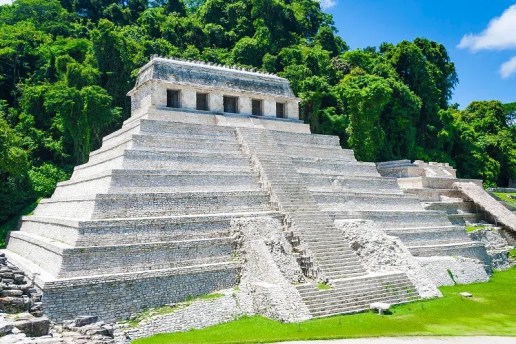There have been various discoveries made till now related to the ancient Mayan civilization. But one of the significant Mayan finds is the enigmatic Maya astronaut engraved on the lid of a sarcophagus discovered in the tomb of King Pakal. The tomb is in Plaenque, an ancient Mayan city located in the Sierra Madre de Chiapas, Mexico.
King Pakal is the mysterious figure who is engraved on the lid. In 1952 his tomb was discovered in the “Temple of Inscriptions.” Ancient astronaut theorists Zachariah and Erich von Daniken were highly inclined towards the Maya king Pakal’s mysterious tomb. According to the theorists, the figure on the lid depicts an ancient astronaut.
Similar to his tomb, the Pakal is situated on the lid in an intermediate space encircled by Maya cosmological paintings and symbols that run down the lid’s sides. He started his reign as king of Palenque at the age of 12 in 615 AD and continued to rule until his death at the age of 80.

He built up this Mayan city and transformed it into a sophisticated urban center in Mesoamerica. As per the historians and archaelogists, the engravings on the lid give us knowledge about the death of the king and his trip to the underworld. In the book “Chariots of the Gods” by Erich von Daniken, it is written that the engravings on the lid depict King Pakal sitting in some sort of spaceship.
According to theorists’ observations, King Pakal could be a member of a highly advanced alien race that established bases on Earth. Palenque is one of the oldest places that suggests the presence of aliens on earth.
Tomb of King Pakal
King Pakal was buried in the Temple of Inscriptions. His body was kept in a sarcophagus that was surrounded by a crypt 9 meters long, with ceilings 7 meters high. It was penetrated by Mexican archaeologist Alberto Rus Luillier in 1949.

Archaeologist Alberto Rus Luillier found various skeletons there that are believed to have died at the time of King Pakal’s burial. According to him, the crypt was dug in the ice. The walls of the crypt are as smooth as they appear to be polished. A stalactite-draped dome and thick stalagmite rise from the ground, giving it the appearance of an old abandoned chapel.
The most mysterious part of the tomb was the sacrophagus’s lid, which weighed around 5 to 20 tons and was engraved with a man dressed in a Mayan outfit sitting in some sort of alien spaceship. The jade and obsidian mosaic masks that covered the faces of the deceased caught archaeologists’ interest.

Another similarity that made the researchers believe that he was an alien was his facial structure. He had a narrow face with large eyes and a long nose that cut through his forehead. Well, there could be a possibility that large, projecting noses on the foreheads could be a feature in the DNA of ancient people, or that they could be descended from a different human species. Ancient figurines excavated on Jaina Island had similar facial features. But the main question that arises is when did our DNA change so radically?
At present, archaeologists argue that the carving on the lid of King Pakal’s sarcophagus is just a representation of the afterlife. According to them, all the elements engraved on the lid simply depict the journey of the spirit of the departed into the world of the dead.

It is widely believed that the mysterious man in the Mayan warrior costume is an alien whom the people of Palenque came across 2,000 years ago and engraved on a rock. Even though officials deny the fact that King Pakal was an alien. The death ceremonies that were observed in the King Pakal tomb had a striking similarity with the funeral rites of the pharaohs in ancient Egyptian tombs. Also the similarity between the Pakal tomb and the crypts of the Egyptian pharaohs cannot be avoided because of the symbols symbolizing a voyage to the afterlife found in both tombs.
Closely studying and comparing the figurines of Pakal’s tomb to the ancient astronauts, it can be hypothesized that King Pakal was one of the Anunnaki who set up a civilization on earth. The Sumerian tablets about the list of kings suggest that by the time of King Pakal’s death, most of the Anunnaki had already left earth. There could be a possibility that King Pakal stayed and the engravings on the lid depict his return to the planet Nibiru.
Leave us your thoughts in the comment section.
Source: ufoac.com









